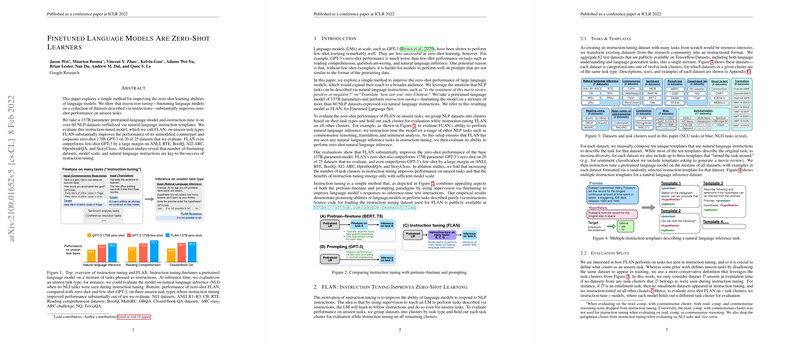Finetuned LLMs Are Zero-Shot Learners
The paper "Finetuned LLMs Are Zero-Shot Learners" by Jason Wei et al. presents an empirical paper on the impact of instruction tuning on large-scale LLMs to enhance their zero-shot learning capabilities. By finetuning a pretrained model on a diverse set of NLP tasks expressed as instructions, the authors significantly improve the zero-shot performance of the LLM on unseen tasks.
Methodology
The authors employed a 137-billion parameter LLM and finetuned it using more than 60 NLP datasets, each phrased via a variety of natural language instructions. This process, termed instruction tuning, creates a model named FLAN (Finetuned Language Net). The key aspect of this approach is the use of instruction templates to describe each task, emphasizing natural language interaction.
To evaluate the zero-shot capabilities of FLAN, the authors composed NLP tasks into distinct clusters based on task types. During instruction tuning, each cluster remained unseen to assess the model's performance on these held-out clusters, ensuring that the evaluation reflected zero-shot learning.
Results
FLAN demonstrated substantial improvements in zero-shot performance compared to its unmodified counterpart and other models. Notably, FLAN outperformed the zero-shot 175-billion parameter GPT-3 on 20 out of 25 datasets evaluated and surpassed GPT-3’s few-shot performance on several key datasets including ANLI, RTE, BoolQ, AI2-ARC, OpenbookQA, and StoryCloze.
Key numerical results include:
- FLAN significantly outperformed GPT-3 in zero-shot settings, with a performance increase of approximately 10-20% on tasks like ANLI and RTE.
- FLAN improved zero-shot performance by 60-80% on reading comprehension tasks (e.g., BoolQ).
- Closed-book QA tasks saw performance gains of 10-15% when using FLAN compared to GPT-3.
Ablation Studies
A comprehensive ablation paper reinforced the importance of various factors:
- Increasing the number of datasets used for instruction tuning led to improved performance on unseen tasks.
- The benefits of instruction tuning were more pronounced in larger-scale models. Indeed, smaller models (8 billion parameters and below) showed negligible or even negative gains from instruction tuning.
- Performance gains were dependent on the natural language instructions themselves. When instructions were absent during finetuning, the models exhibited worse zero-shot performance.
Implications and Future Directions
The practical implications of this paper are profound. By demonstrating that instruction tuning can leverage existing supervised datasets to improve a general model’s performance on unseen tasks, the research indicates a pathway for deploying more versatile and user-friendly AI models. This approach reduces the reliance on large amounts of task-specific data and domain-specific expertise to achieve high performance in practical applications.
Theoretically, the results suggest that LLMs can implicitly learn the structure of a wide variety of tasks from natural language descriptions. This capability paves the way for further innovations in multi-task learning and transfer learning, potentially leading to even more adaptable AI systems.
The paper also opens several future research avenues:
- Extending instruction tuning to cross-lingual tasks to explore zero-shot performance in multilingual settings.
- Investigating the thresholds of model size and task complexity where instruction tuning offers diminishing returns.
- Exploring the combination of instruction tuning with prompt tuning or other finetuning methodologies to further enhance model capabilities.
Conclusion
This paper provides compelling evidence that instruction tuning significantly enhances the zero-shot learning abilities of LLMs. By finetuning on a diverse set of tasks expressed as natural language instructions, the FLAN model outperforms comparable models in zero-shot scenarios. This research underscores the potential of using instructional datasets to improve the versatility and accessibility of AI-driven solutions in NLP, making it a noteworthy contribution to the field.
